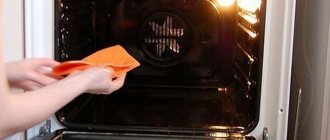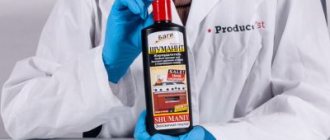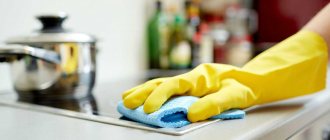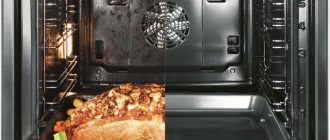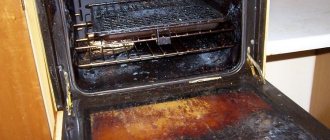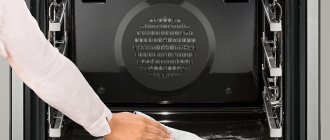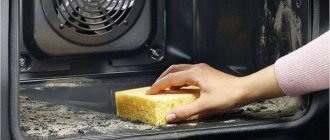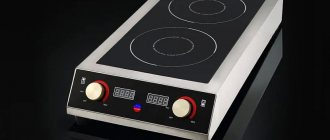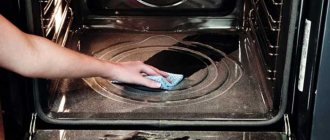An oven is an invariable attribute of a modern kitchen, a good alternative to a Russian stove. All kinds of healthy dishes are prepared in gas and electric ovens.
While the turkey was cooking, large drops of fat formed on the walls and bottom of the oven. The fat and surface molecules polymerize and form a thick “glazed” crust.
During the cooking process, fat and food juices inevitably get onto the inner walls, forming an unpleasant-smelling soot that is not washed off with ordinary water.
Sticky grease can be difficult to clean, even with a strong detergent and a stiff sponge.
Traces of food and other contaminants are removed using household chemicals; cleaning the oven with steam is popular. Pyrolysis, catalysis, hydrolysis are used. Each technology has its own advantages and disadvantages. So, it is proposed to choose the best option for cleaning surfaces.
Modern manufacturers offer three options for cleaning the oven chamber.
Features of steam oven cleaning
The hot steam treatment method has been used for a long time, since the advent of the first models of built-in and stationary stoves. The method does not involve the use of cleaning agents; steam treatment greatly facilitates further cleaning. After hydrolysis, remove all excess with a napkin. Cleaning an oven stove from charred food particles and rancid fat stains is a labor-intensive process; the cleaning procedure is unpleasant and requires a lot of effort and time.
Pyrolysis, catalysis, hydrolysis: what is the most effective method of cleaning an oven?
Note! Steam not only makes work easier for housewives, but also disinfects internal surfaces from possible bacteria and moldy fungi.
What it is?
Using steam to remove grease and burns from the interior walls of a cabinet is called hydrolysis. A comparison with the sterilization of jars for blanks will help you better understand what steam cleaning of an oven is. During processing, the metal is not damaged and oxidation processes are not activated.
Steam cleaning, or hydrolysis cleaning, is a simple way to remove grease from the inner walls of the oven without resorting to aggressive household chemicals.
Pros and cons of hydrolysis
Steam cleaning cannot be called a completely automatic removal of contaminants in the oven. But this treatment greatly simplifies the process of caring for the stove. Hydrolysis has its advantages and disadvantages compared to other methods
Pros:
hydrolysis will not require the cost of expensive household chemicals;- since cleaning occurs at relatively low temperatures, energy consumption is low;
- steam cleaning helps save time; After the procedure, all that remains is to remove the softened stains with a rag - this is much more convenient than scrubbing dried stains with force for a long time;
- the hydrolysis process is safe - since the exposure temperature is low, the cabinet door does not overheat and the risk of getting burned is minimal.
Minuses:
- after the procedure is completed, dirt may remain on the cabinet walls that will have to be removed manually;
- to remove stubborn stains, the cleaning procedure will have to be repeated or removed manually - for this reason, it is recommended to carry out the process of treating the oven with steam in a timely manner;
- hydrolysis can only be carried out after the oven has completely cooled; You should not organize such cleaning immediately after finishing cooking.
Advantages and disadvantages of steam cleaning
The undeniable advantages are obvious:
- no need to spend additional funds;
- the risk of burns is unlikely, the steam cools quickly;
- the doors do not overheat, the process is safe for household members.
Absolutely anyone can cope with this oven cleaning system, even if they have virtually no skills in using kitchen appliances.
Now about the disadvantages, there are also some:
- you have to finish cleaning with a rag;
- hydrolysis does not remove all contaminants;
- The stove or stove must be dried, this is especially true for electrical appliances.
Built-in furniture can withstand temperatures of no more than 70 degrees.
Note! It is strictly forbidden to use the oven immediately! It is advisable to wait 2 days.
How to clean an oven with steam
The built-in hydrolysis function is, of course, a benefit, but for older models, “water procedures” can be done manually. It is worth saying more about the features of steam cleaning.
Hydrolysis cleaning
A modern oven eliminates unnecessary hassle. At the end of the procedure, the alarm system is activated. Hydrolysis cannot be called an automatic method; you have to wipe the oven manually. With regular use, it is possible to avoid hardened deposits on the walls.
Steam oven cleaning is more of a semi-automatic function and makes the cleaning process very easy.
Features of household appliances with hydrolysis
The Aqua Clean model allows you to add a solution containing non-aggressive dishwashing detergent. The fat on the walls is easily removed, everything flows down. At the bottom of the stoves there is a tray for collecting contaminants washed away by steam. The self-cleaning function in the oven operates in different modes, at different temperatures from +90°C to 150°C.
There are models where maximum heating is limited to a temperature of +50°C; steam is supplied from a built-in steam generator.
Hydrolysis cleaning functions in modern ovens
Manufacturers are improving built-in ovens. The “Cleaning” self-cleaning function allows the use of cleaning sprays. The modern type of slabs is easy to keep clean; it is enough to treat the surface with a product recommended by the manufacturer before starting hydrolysis. Other substances are unacceptable for this method. The self-cleaning system frees up a lot of time.
Inexpensive models are produced under the brands Beko, Ariston, Electronicsdeluxe.
Which technology is better?
Comparison with catalytic system
Catalytic purification is fully automated , while hydrolytic removal of contaminants requires process control and human participation. However, the cost of ovens with a catalytic function significantly exceeds the cost of devices with hydrolysis cleaning.
Catalytic panels coated with self-cleaning enamel require periodic replacement . In addition, the absorbent and fat-breaking surface is applied only to the top and side walls of the oven, the inside of the door, and the bottom of the appliance still need to be cleaned manually.
The steam generated when the hydrolysis function is turned on is evenly distributed over all internal surfaces of the equipment. In addition, the energy consumption during the procedure for devices with hydrolysis cleaning will be significantly less than for devices equipped with catalytic panels.
IMPORTANT! Of course, the catalytic method is more effective and progressive, but when choosing a device with a particular function, you should take into account the intensity of use of the oven, financial capabilities and your own preferences.
Pyrolysis technology
The pyrolytic system can be called the most effective method of cleaning a household appliance . You do not have to, as is the case with the hydrolysis or catalytic method, manually wash the walls or door - all the contaminants that are present inside the device will completely turn into ash.
Therefore, if you are a fan of experimenting in the kitchen and often use the oven to create culinary masterpieces, appliances with such a system will become your indispensable assistant.
During the process of pyrolysis cleaning, a household appliance consumes a large amount of electricity , so when purchasing equipment, be sure to purchase a power cable that can withstand power up to 6 kW.
ATTENTION! Unlike ovens with a steam system, during pyrolysis cleaning the walls of the household appliance become very hot, which should be taken into account when choosing a place to install the stove: it is unacceptable to place the device in close proximity to furniture, a refrigerator and other interior items.
Other oven cleaning methods
The ease of cleaning the oven depends on the materials used and built-in functions. In addition to hydrolysis, pyrolysis and catalysis are common.
Self-cleaning enamel
This is the so-called catalytic method. Glassy walls, rough to the touch, covered with pores. Enamel repels dirt well. Acts as a catalyst for the decomposition of fats at high temperatures. Fats and food particles that get on the walls break down into water and easily removed dry ingredients.
Catalysis is considered a low-temperature purification method - oxidation occurs at a temperature of 140-200°C
Attention! Enamel is destroyed by sugar and lactose. Be careful when preparing baked goods. The bottom is made of metal and will have to be washed by hand.
Application of pyrolysis
The pyrolytic process occurs at high temperatures; the metal is heated to +500°C. Fatty residues and food simply burn out. Pyrolysis is carried out with grates, baking sheets, and heat-resistant baking containers. During heat treatment, all surfaces are cleaned at once. A significant disadvantage of the models is that the treatment is accompanied by an unpleasant burning smell; the doors do not close hermetically.
The toughest and most effective cleaning method. During pyrolysis, all food remains burn to ashes.
Note! The function consumes a lot of energy; an additional 6 kW cable is connected to the ovens.
The best oven cleaners
Manufacturers usually recommend a specific composition. To remove stubborn stains manually, it is better to purchase proven products:
- Amway is thick, stays on dirt for a long time, and is easily washed off;
- Unicum removes fresh stains quite well;
- Sanitol contains alkali, a lethal but unsafe agent;
- Faberlic starts the process of biological decomposition of fat components;
- Schumanite will make the old surface attractive;
- Dr.Beckmann – universal cleaner for ovens and dishes;
- Chistomix – safe, based on natural ingredients;
- Dirtbusters are a very effective oven cleaner.
How to steam clean without hydrolysis technology
Self-hydrolysis involves the use of baking trays with high sides or large baking containers. Water is poured into the container (500–700 ml is enough for an average oven), placed on the lowest tier or placed on the bottom (it all depends on the model of the stove or stove). Turn on the heating.
In inexpensive models, a container or recess may not be provided.
As soon as steam begins to form, the heat is reduced. The hydrolysis process has started. When the cabinet heats up from the outside, open the door and check the degree of plaque softening. You should not heat the stove for more than half an hour.
When the appliance finishes the cleaning process, you need to open the door so that the inside surface cools down a little.
Important! During “water procedures” the operation of the device must be monitored and the door must be opened slightly if necessary. When the water has evaporated, remove the pan.
Hydrolysis cleaning functions in modern ovens
A large number of modern oven models have a Cleaning function, which requires cleaning using sprays that replace steam. In this case, it must first be heated to 90 degrees. After 15 minutes, when the door opens, you need to treat the walls as quickly as possible with a special care spray and close the door.
When the oven has cooled completely, remove any traces of:
- liquids;
- spray;
- split fat.
For those who are interested in what it is to steam clean ovens of modern modifications, it is worth highlighting such a function as Aqua Clean. It operates at low temperatures. Pour 0.5 liters of water into the baking tray and set the cleaning mode. After heating the oven to 50 degrees, cleaning will be carried out for half an hour. Then the door is opened and the dirt is removed. Premium ovens with a hydrolysis program are also available. It activates cleaning, you can select the intensity and time for it on the timer.
Additional recommendations
The treatment is carried out with relatively low heat; it is enough to raise the temperature to +90°C. With intense steaming, hot water settles on the walls, and the hot condensate softens the impurities.
Hydrolysis occurs in gas and electric ovens, as opposed to a high temperature cleaning system (pyrolysis).
Limitations in detergents are associated with the use of special materials and sealants. Incorrect household chemicals may cause the door to close worse, and grease will accumulate under the glass.
This is usually a quick steam treatment and a full thirty minute cycle. The latter is best used about once every 1–2 months.
You need to wear gloves when working with household chemicals. Not only the skin, but also the manicure suffers from aggressive components.
Important! If the procedure is carried out irregularly, you will have to tinker with old stains; they will have to be soaked using traditional methods and cleaned using special means.
When purchasing an oven, you should carefully read the instructions. Cleaning functions will not be superfluous; any housewife will be happy with them. You don't have to clean the stove manually.
A similar procedure is carried out ideally after each cooking process in the cabinet. Many mid- and premium-segment models have several hydrolysis modes.
Which ovens have a hydrolysis function?
Manufacturers of household appliances produce many different models of ovens equipped with a hydrolysis cleaning function. Prices for household products vary from 12 thousand rubles to 115-120 thousand rubles.
The most inexpensive models include ovens:
- Electronicsdeluxe 6009.01eshv-000;
- Hotpoint-Ariston FH 21 BK;
- Beko BCM 12300 X and others.
The hydrolysis cleaning function can be used in both gas ovens and electrical appliances.
